Three Pakistani labourers stand with mountains of the Himalayan Karakoram range in 2004. One of the world's biggest glacier regions has so far resisted global warming that has ravaged mountain ice elsewhere, scientists reported on Sunday.
One of the world's biggest glacier regions has so far resisted global warming that has ravaged mountain ice elsewhere, scientists reported on Sunday.
For years, experts have debated the state of glaciers that smother nearly 20,000 square kilometres (7,700 sq. miles) of the Karakoram range in the western Himalayas.
Straddling parts of China, Pakistan and India, the Karakoram's peaks include K2, Earth's second-highest mountain.
Its glaciers account for nearly three percent of the world's area of ice outside the ice sheets of Greenland and Antarctica.
In locations around the planet, mountain glaciers are shrinking in response to higher temperatures, contributing importantly to sea-level rise.
Yet the situation for the Karakoram has until now been sketchy.
Scientists have found it almost impossible to study the glaciers on the ground, for the region lies at great altitude in a border area, and access is hampered by snow avalanches and glacial debris.
But a French team, comparing 3-D satellite maps from 2000 and 2008, said the glaciers had not lost mass over this period and may even have grown a tiny bit, at 0.11 millimetres (0.04 of an inch) per year.
"Apparently, the situation in the Karakoram is a little different (from elsewhere), which means that the glaciers are stable for the time being," Julie Gardelle of the University of Grenoble in southeastern France told AFP.
"But it does not detract in any way from the evidence for overall global warming," she cautioned.
The paper, published in the journal Nature Geoscience, is based on satellite scrutiny of 5,615 sq. km. (2,167 sq. miles) of the central Karakoram, between the Yarkant River on the Chinese side of the border and the Indus River on the Pakistani side.
The study area lies outside the Siachen glacier, the scene of a military standoff between Pakistan and India, which according to the Sustainable Development Policy Institute in Islamabad has shrunk by 10 kilometres (six miles) in the past 35 years.
In a commentary also carried by Nature Geoscience, Graham Cogley of Trent University in Ontario, Canada, said it was unclear why the Karakoram had so far been spared the impact of warming.
"It seems that, by a quirk of the atmospheric general circulation that is not understood, more snow is being delivered to the mountain range at present, and less heat," said Cogley.
The health of the Himalayan glaciers is closely watched, for they supply water for more than a billion people in South Asia and China.
In February, a US-led study published in Nature found that ice loss from the Himalayas was significant but had been badly over-estimated.
It calculated loss of four billion tonnes a year, compared with previous estimates of up to 50 billion.
It said past estimates were based on runoff from lower-altitude glaciers -- which are worse hit by warming than higher-altitude ones -- and on drainage figures from the vast plains south of the Himalayas.
Much of this drainage came in fact from water that had been pumped from underground aquifers on the plains, not from meltwater from the mountains, the study said.
More information: DOI: 10.1038/ngeo1450
(c) 2012 AFP





















